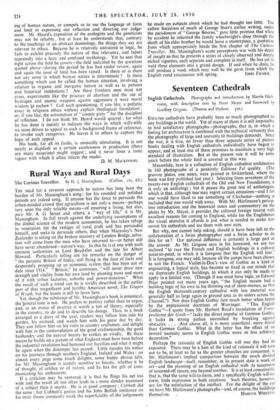Seventeen Cathedrals
English Cathedrals. Photographs and introduction by Martin Midi- mann, with descriptive text by Peter Meyer and foreword by Geoffrey Grigson. (Thames and Hudson. 305.)
ENGLISH cathedrals have probably been as much photographed as any buildings in the world. Yet of many of them it is still impossible to find satisfactory photographs—photographs, that is, in which a feeling for architecture is combined with the technical virtuosity that the photography of large and unevenly lit buildings demands. Since the war, it is true, no fewer than three separate series of picture books dealing with English cathedrals individually have begun to appear, and at least one of them promises to maintain a very high standard of illustration. But at the present rate it will be some years before the whole field is covered in this way.
Meanwhile, here is a collection of English cathedral architecture in 160 photographs of a positively Editions Tel quality. (The gravure plates, one notes, were printed in Switzerland, where the book was first published last year.) Selecting from seventeen of the twenty-two English cathedrals of the Old and New Foundations, it is only an anthology ; but it passes the great test of anthologies, which is that, although trie'may regret certain omissions—and I for one would have liked to see something of Chichester—nothing is included that one would wish away. With Mr. Htirlimann's percep- tive introduction and the historical notes and commentary on the plates by Mr. Meyer, it provides the cultured foreign tourist with excellent reasons for coming to England, while for the Englishman the visual stimulus it affords is just what is needed to make him revisit his cathedrals and see them with new eyes.
But why, one cannot help asking, should it have been left to the collaboration of a Swiss photographer and a Swiss scholar to do this for us ? Our national diffidence is certainly a large part of the answer. As Mr. Grigson says in his foreword, we are too inclined " to race the French and English buildings in a cultural point-to-point, in which it is foregone that the English will lose." It is foregone, one may add, because all the jumps have been chosen to suit the French: Viollet-le-Duc's view of Gothic as a kind of engineering, a logical style, has become so fixed in our minds that we depreciate English buildings, to which it can only be made to apply M a limited way. (Though if one must have logic, as Edward Prior pointed out many years ago, " the English mason had a building logic of his own in his thinning out of stone-masses, so that the English thirteenth-century cathedral with less material was generally half as large again in ground area as its sisters across the Channel.") Nor does English Gothic fare much better when tested by the expressionist doctrines of Worringer. " This English Gothic "—I quote from Mr. Herbert Read's translation of Form- probleme der Gotik—" lacks the direct impulse of German Gothic, it lacks its strong pathos intensified by breaking against obstacles. . . . And above all, it is more superficial, more trivial than German Gothic. What in the latter has the effect of an inward necessity seems in English Gothic more or less arbitrary decoration."
Perhaps the rationale of English Gothic will one day find its expositor. There may be a hint of the kind of rationale it will turn out to be, at least so far as the greater churches are concerned, in Mr. Htirlimann's implied comparison between the much divided English landscape—itself, remember, in its present state a work of art—and the planning of an English cathedral with its succession of screened-off spaces, one beyond another. It is at least conceivable, that is, that the same will-to-form, and a specifically English will-to- form, finds expression in both creations. Such theories, however, are for the satisfaction of the intellect. For the delight of the eye we have Mr. Hiirlimann's photographs—and, of course, the buildings


































 Previous page
Previous page